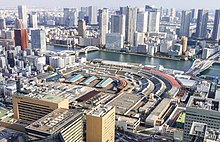Tsukiji fish market
The Tsukiji fish market ( Japanese. 築 地 市場 , Tsukiji shijō , dt. "Tsukiji market") in the eponymous district of Tsukiji in the Tokyo district of Chūō was the largest fish market in the world. The market in Tsukiji was part of the central wholesale market , the name of the market for foreigners, which is often used here, is misleading in that, in addition to fish, vegetables and fruits were traded in Tsukiji.
meaning
In 2003, 615,409 tons (2,246 tons daily) of fish and seafood were sold from the central wholesale market - there are further fish markets in Ōta and Adachi . Around 90% of the aforementioned trading volume was accounted for by the Tsukiji fish market.
history
The historical roots of the fish market go back to the 16th century, when the shogun Tokugawa Ieyasu brought fishermen from Osaka to Edo to supply his farm with fish. He also gave them permission to sell the fish not delivered to the court near the Nihombashi . At the same time, the trade in vegetables and fruits developed. The market was badly damaged by the Great Kantō earthquake in 1923 , but was rebuilt in Nihombashi. It was not until 1935 that the company moved to Tsukiji, with the buildings being built in the German New Objectivity style.
According to the wishes of the former governor of Tokyo Prefecture , Shintarō Ishihara , the market should be relocated to the Toyosu district in the Kōtō district, around 2 km away, by the end of the 2014 fiscal year (March 2015) . The Democratic Party , which was the strongest force in the prefectural parliament from 2009 to 2013, initially rejected the relocation location in a former gas works that was contaminated with carcinogenic substances, but ultimately gave up its resistance and a majority agreed in the budget deliberations for the 2012 fiscal year to finance the move.
After the relocation date had been postponed several times due to the harmful substances in the soil, the final shutdown was also due to a rat plague in November 2016, which was then postponed to October 2018 by Governor Yuriko Koike in August 2016. So far, around 900 dealers have offered up to 480 species of marine animals worth around 14 million euros a day. The move began on October 5, 2018 and was completed on October 11.
Among other things, a temporary press center for the 2020 Summer Olympics is to be built on the previous site .
Web links
- Official website of the fish market (Japanese) ( Memento from October 25, 2018 in the Internet Archive )
Individual evidence
- ^ Theodore C. Bestor: Tsukiji: The Fish Market at the Center of the World . University of California Press, 2004, ISBN 0-520-22023-4 , pp. 340 ( limited preview in Google Book search).
- ↑ Tsukiji to relocate to Toyosu: Ishihara. DPJ ranks vow to block budget for shift to toxic site. In: The Japan Times . October 22, 2010, accessed October 21, 2010 .
- ↑ Fish fight. Tokyo's governor is starting to look like yesterday's sushi. In: The Economist . October 28, 2010, accessed November 2, 2010 .
- ↑ 築 地 市場 、 14 年度 移 転 確 実 に 都 議会 委 が 予 算 案 可 決 . In: nikkei.com . March 27, 2012, Retrieved January 11, 2016 (Japanese).
- ↑ ANDREA DIENER: In the belly of the sea. In: faz.net. Frankfurter Allgemeine Zeitung, March 20, 2018, accessed on March 21, 2018 .
- ↑ in: Tagesspiegel, October 5, 2018.
- ^ So long, and thanks for all the fish, in: The Economist, Jan 9th 2016.
Coordinates: 35 ° 39 ′ 40.9 ″ N , 139 ° 46 ′ 12 ″ E


